Table Of Content
- 1 Introduction
- 2 Understanding Electrical Sources
- 3 Independent Sources
- 4 Dependent Sources
- 5 Key Differences Between Independent and Dependent Sources
- 6 The Role of Sources in Circuit Analysis
- 7 Advanced Applications and Circuit Examples
- 8 Practical Considerations and Troubleshooting
- 9 Historical Perspective and Theoretical Evolution
- 10 Future Trends and Innovations
- 11 Conclusion
Introduction
Electrical circuits form the backbone of modern electronics and power systems. At the core of these circuits lie various sources that supply the energy required for operation. Among these, independent sources and dependent sources are two fundamental categories that every electrical engineer and electronics enthusiast must understand.
In this comprehensive guide, we will explore the definitions, characteristics, differences, and applications of these sources. We will also dive into how each type is used in practical scenarios and why these distinctions are critical in designing and analyzing complex circuits. Whether you are a student, educator, or professional engineer, this article aims to enhance your knowledge and provide you with insights into the dynamic world of electrical sources.
Understanding Electrical Sources
Before we delve into the specific types, it is important to understand what we mean by “sources” in electrical circuits. An electrical source is any device or component that provides electrical energy to a circuit. This energy can be delivered in the form of either constant voltage or constant current.
The two broad categories of sources are:
- Independent Sources
- Dependent Sources (Controlled Sources)
Both of these sources come in two primary forms:
- Voltage Sources: These supply a fixed or controlled voltage.
- Current Sources: These supply a fixed or controlled current.
Independent Sources
Definition
An independent source is a circuit element that delivers a fixed voltage or current regardless of the circuit conditions. Its output is predetermined and does not change based on other circuit variables. For example, when you connect a battery to a circuit, the battery provides a set voltage independent of the load attached to it (within its operational limits).
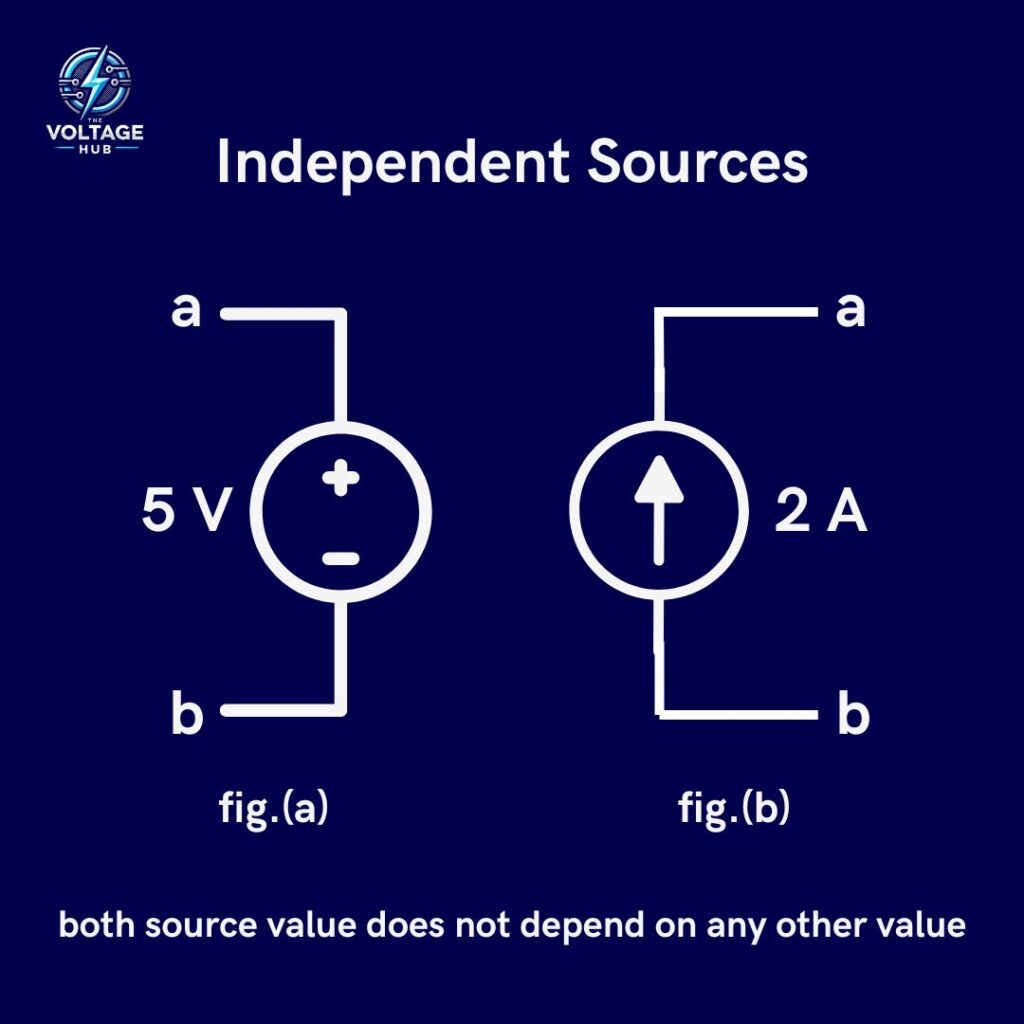
Types of Independent Sources
Independent sources can be further classified into:
- Independent Voltage Sources
- These devices maintain a constant voltage across their terminals.
- Examples: Batteries, DC power supplies, and generators.
- They are designed to produce a fixed potential difference even if the load changes, making them a reliable source of voltage in many applications.
2.Independent Current Sources
-
- These devices supply a constant current regardless of the voltage across them.
- Examples: Laboratory current sources used in experiments and certain power supply circuits.
- The current remains fixed while the voltage may vary depending on the load resistance.
Characteristics of Independent Sources
- Constancy: They provide a constant output value (voltage or current), making circuit analysis simpler.
- Predictability: Their behavior is not influenced by other elements in the circuit, providing a reliable reference in both theoretical analysis and practical implementations.
- Simplicity: In circuit models, independent sources are treated as having ideal behavior, which simplifies mathematical calculations and simulations.
Real-World Applications
Independent sources are used extensively across various domains:
- Consumer Electronics: Batteries in portable devices such as smartphones and laptops.
- Industrial Power Supplies: Large generators and transformers that provide steady voltage and current in power grids.
- Educational Tools: Ideal independent sources are used in academic settings to help students understand fundamental circuit concepts.
Detailed Example: The Battery in a Circuit
Consider a simple circuit with a 9V battery connected to a resistor. The battery is an independent voltage source. It provides a constant 9V irrespective of the resistance value, as long as the battery is not overloaded. This scenario can be analyzed using Ohm’s Law (V = IR), where the current through the resistor is directly proportional to the voltage provided by the battery and inversely proportional to the resistance.
Dependent Sources
Definition
A dependent source, also known as a controlled source, is a circuit element whose output is a function of another voltage or current present in the circuit. Unlike independent sources, the value provided by a dependent source changes dynamically based on the controlling variable, which is a critical feature in many advanced electronic designs.
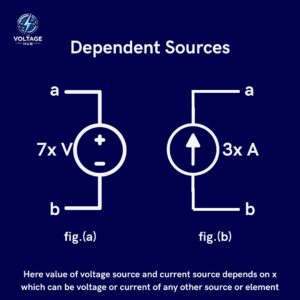
Types of Dependent Sources
Dependent sources are categorized based on what controls their output:
- Voltage-Controlled Voltage Source (VCVS)
- This source outputs a voltage that is directly proportional to an input voltage elsewhere in the circuit.
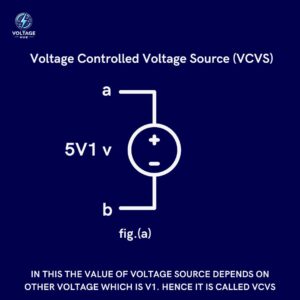
- Example: Used in operational amplifier (op-amp) circuits where the output voltage is a multiple of the input voltage.
- The proportionality constant (gain) determines how much the input voltage is amplified or attenuated.
- Current-Controlled Voltage Source (CCVS)
- Here, the output voltage depends on a current from another part of the circuit.
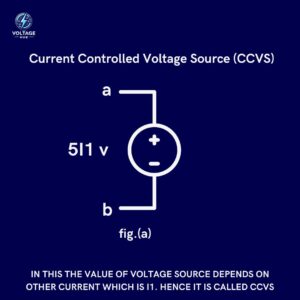
- Example: Found in certain transistor amplifier configurations.
- A current elsewhere in the circuit is used to modulate the output voltage, which is particularly useful in feedback and stabilization circuits.
- Voltage-Controlled Current Source (VCCS)
- This type produces a current that is proportional to an input voltage.
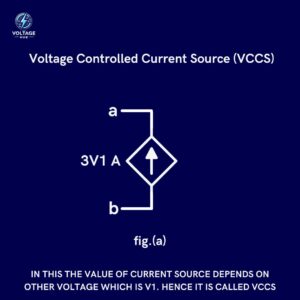
- Example: Utilized in field-effect transistor (FET) circuits.
- The output current can be adjusted by changing the input voltage, making it ideal for precision control applications.
- Current-Controlled Current Source (CCCS)
- In this source, the output current is directly proportional to a controlling current from elsewhere in the circuit.
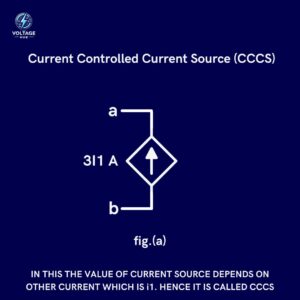
- Example: Common in bipolar junction transistor (BJT) amplifier circuits.
- The gain factor here determines the magnitude of the output current relative to the controlling current.
Characteristics of Dependent Sources
- Variable Output: The output is not fixed but varies according to a controlling variable.
- Circuit Interaction: Their behavior is intrinsically linked to other circuit elements, making them a central part of feedback and control systems.
- Application in Amplification: They are essential in amplifiers and oscillators, where precise control over signal parameters is needed.
Mathematical Representation
In circuit analysis, dependent sources are represented with a multiplier that relates the output to the controlling variable. For example:
- For a VCVS:

- For a VCCS:

Here, A and g are the gain constants. These mathematical representations allow engineers to model and predict the behavior of circuits with dependent sources accurately.
Detailed Example: Operational Amplifiers in Signal Processing
Operational amplifiers (op-amps) are a practical example where dependent sources are at work. In many op-amp configurations, the output voltage is a controlled source, dependent on the input voltage and the feedback network. A typical non-inverting amplifier circuit uses a VCVS to provide a gain that is determined by the ratio of resistors in the feedback loop. This dependent behavior is critical for achieving high accuracy in amplification tasks, such as in audio equipment, instrumentation, and sensor applications.
Key Differences Between Independent and Dependent Sources
To better understand their roles, let’s compare independent and dependent sources in a structured manner.
| Feature | Independent Source | Dependent Source |
|---|---|---|
| Control | Output is fixed and independent | Output is controlled by another voltage or current |
| Types | Voltage and Current Sources | VCVS, CCVS, VCCS, CCCS |
| Behavior | Constant output regardless of load changes | Dynamic output based on circuit conditions |
| Applications | Batteries, power supplies, generators | Amplifiers, oscillators, and sensor circuits |
| Mathematical Model | Fixed value (e.g., 9V battery) | Scaled variable (e.g., |
| Circuit Analysis Complexity | Generally simpler | Requires accounting for the controlling variable |
The table above illustrates that while independent sources provide a constant and predictable value, dependent sources introduce a level of complexity that is necessary for modern electronic design, especially in feedback and control systems.
The Role of Sources in Circuit Analysis
Independent Sources in Theoretical Analysis
When analyzing circuits, independent sources often serve as the starting point for understanding overall behavior. They allow for straightforward application of fundamental laws like Ohm’s Law, Kirchhoff’s Voltage Law (KVL), and Kirchhoff’s Current Law (KCL). Their constant output means that they can be replaced with their numerical values during the calculation process, making it easier to solve circuits using techniques like nodal analysis or mesh analysis.
Dependent Sources in Practical Circuit Design
Dependent sources, while adding complexity, are crucial in practical applications. Their ability to respond to changes in other parts of the circuit makes them indispensable in:
- Feedback Mechanisms: Stabilizing and controlling amplifiers.
- Signal Processing: Enhancing and modulating signals for audio and radio frequency applications.
- Control Systems: Precisely adjusting outputs in response to sensor inputs or environmental changes.
For instance, in a negative feedback amplifier, a dependent source helps regulate the output to prevent distortion, ensuring that the amplifier maintains a linear response over a wide range of input signals.
Advanced Applications and Circuit Examples
Amplifier Circuits
Amplifiers are perhaps the most common applications of dependent sources. In both BJT and FET amplifiers, dependent sources are used to model the behavior of transistors. The amplification process inherently relies on a small input signal controlling a larger output signal. Here’s how dependent sources are incorporated:
- Small-Signal Models: In small-signal analysis, transistors are represented by their equivalent circuits containing dependent sources. For instance, a transistor may be modeled with a VCCS that represents the transconductance, linking the input voltage to the output current.
- Feedback and Stability: Negative feedback circuits use dependent sources to achieve stability. By feeding a portion of the output back into the input, these circuits can counteract variations and maintain consistent performance.
Oscillators and Signal Generators
Oscillators rely on the interaction of independent and dependent sources to produce a periodic output signal. Dependent sources are integral in controlling the frequency and amplitude of the oscillations. In phase-shift oscillators, for example, a dependent voltage source in the feedback network helps establish the necessary phase shift and gain conditions for sustained oscillations.
Power Regulation and Voltage Conversion
Voltage regulators and converters (such as buck and boost converters) often include circuits where dependent sources play a role in controlling the output voltage. Here, the dependent source responds to changes in load or input voltage, ensuring a stable and regulated output. This functionality is critical in modern power supply units where efficiency and precision are paramount.
Practical Considerations and Troubleshooting
Common Pitfalls in Circuit Design
While working with both independent and dependent sources, engineers must be aware of several potential issues:
- Loading Effects: Even though independent sources are idealized as having fixed outputs, real-world sources can be affected by load variations. Designing with proper load matching and impedance considerations is essential.
- Stability Concerns: Dependent sources can introduce instability if not properly managed. This is especially true in high-gain amplifier circuits where oscillations or unintended feedback loops may occur.
- Model Limitations: The theoretical models for independent and dependent sources assume ideal behavior. In practice, factors like internal resistance, non-linearities, and temperature variations can affect performance.
Testing and Measurement
To ensure that circuits function as intended:
- Simulation Tools: Use simulation software (such as SPICE) to model circuits before physical implementation. These tools allow for detailed analysis of both independent and dependent source behavior.
- Instrumentation: Oscilloscopes and multimeters are indispensable for measuring circuit parameters. For example, measuring the output of a dependent source in an amplifier circuit can verify whether the gain and linearity are within expected ranges.
- Iterative Prototyping: Building and testing prototype circuits can help identify issues that may not be evident in simulation. Iterative testing is particularly important in circuits with sensitive dependent sources.
Historical Perspective and Theoretical Evolution
The evolution of circuit theory has significantly shaped our understanding of independent and dependent sources. Early circuit models in the 19th and early 20th centuries primarily dealt with independent sources, reflecting the simpler electronic devices of the time. However, as technology advanced and the demand for more sophisticated electronic functions grew, the need for modeling controlled sources became apparent.
The Birth of Dependent Source Theory
The development of dependent source theory can be closely linked to the invention of the transistor and the subsequent rise of semiconductor electronics. Engineers had to create more complex models that could account for the behavior of transistors, leading to the formal introduction of dependent sources in circuit theory textbooks and research papers. These models have since evolved, becoming an integral part of modern circuit analysis and design.
Impact on Modern Electronics
Today, the concepts of independent and dependent sources are not just academic—they are vital in the design of virtually every electronic device. From the smartphones in our pockets to the large-scale power systems that light up our cities, these sources play an indispensable role. Their precise modeling and control are fundamental to achieving the efficiency, stability, and performance required in modern electronics.
Future Trends and Innovations
As electronics continue to evolve, so too will the models and applications of independent and dependent sources. Emerging technologies such as flexible electronics, wearable devices, and smart grids are pushing the boundaries of what is possible in circuit design.
Integration with Digital Systems
Modern circuits increasingly integrate analog and digital components. Dependent sources, with their inherent ability to provide controlled outputs, are essential in bridging the gap between these two realms. Innovations in mixed-signal processing and analog-to-digital conversion continue to leverage dependent source models to improve performance and accuracy.
Energy Harvesting and Smart Power Systems
With the growing emphasis on energy efficiency and renewable energy sources, dependent sources are finding new applications in energy harvesting circuits. These circuits often need to adapt dynamically to varying input conditions—something that dependent sources can handle adeptly. The integration of smart control systems and sensors further enhances the performance of these circuits, ensuring optimal energy conversion and usage.
Advancements in Simulation and Modeling
The future of circuit design will likely see more advanced simulation tools that incorporate real-world effects more accurately. As these tools evolve, they will provide even more precise models of independent and dependent sources, allowing for more reliable predictions and innovative circuit designs. This evolution will drive the development of next-generation electronics with unprecedented performance and efficiency.
Conclusion
Understanding the distinction between independent and dependent sources is fundamental for anyone involved in electrical engineering and circuit design. Independent sources, with their fixed output, provide the stable foundation necessary for many basic circuits. In contrast, dependent sources offer the flexibility and control needed in advanced applications such as amplifiers, oscillators, and regulated power supplies.
By mastering the principles outlined in this article, engineers can more effectively analyze, design, and troubleshoot circuits. Whether you are working on a simple battery-powered device or a complex integrated circuit, recognizing the role of these sources will lead to more robust and efficient designs.
The journey of exploring these sources also highlights the remarkable evolution of circuit theory—from the basic models of the past to the sophisticated, dynamic systems of today. As technology continues to advance, both independent and dependent sources will remain at the heart of innovation in electronics.
For further learning, consider exploring textbooks on circuit analysis, attending workshops, and using simulation tools to experiment with different circuit configurations. Staying updated with emerging trends and technological advancements will ensure that your understanding of these fundamental concepts continues to grow.
In summary, the interplay between independent and dependent sources is not just a theoretical exercise; it is a practical, essential aspect of modern electronic design that affects everything from everyday gadgets to critical infrastructure systems. Embrace the complexity, explore the details, and use this knowledge to drive your innovations in the fascinating field of electronics.



Superb blog! Do you have any hints for aspiring writers?
I’m planning to start my own site soon but I’m a little lost on everything.
Would you recommend starting with a free platform like WordPress or go for a paid option? There are so many options out there that I’m totally confused ..
Any suggestions? Bless you!
Thank you for your kind words! It’s great to hear that you’re planning to start your own site.
If you’re just getting started, a free platform like WordPress.com or Blogger can be a good way to explore blogging without any upfront costs. However, if you’re serious about building a long-term website, I’d recommend going with a self-hosted WordPress.org site. It gives you more control, customization options, and a professional look.
The key is to start—don’t get stuck in overthinking! Focus on writing valuable content, stay consistent, and learn as you go. If you ever need help, feel free to reach out. Wishing you all the best on your blogging journey! 😊